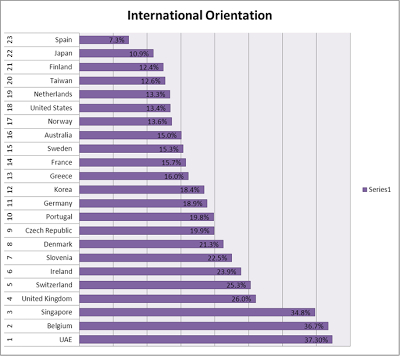A year ago the young man, Hassan Al Shamala who hosted us so generously in his home, was drowned when a strong wadi swept his car away. Hassan was the first in his family to attend university and his family was very proud that he was a university graduate and an officer in the military. He was greatly loved by all his fellow students, from every Emirate.
He was also very special to all faculty and staff who learned so much about Emirati culture, from sword dancing to mountain living to an absolute generosity of spirit that still holds the most special memories for me.
Thank you Hassan for the beautiful memories described in this post and the many joyous moments you created for so many of us.
| Hassan in his mountains - RAK (Photo by Marco Sosa) |
This blogpost was written using first hand research done by the young Emirati men in my BUS 402 Strategy class in Fall 2012. We also took a field trip to the mountains of Ras al-Khaimah (organised by the men) and were hosted by Hasan and his father in their mountain home. On behalf of the class and David Ribott, a Student Life specialist who also came with us, I want to say a very public thank you to Hassan Rashed Bani-Shmeili and his father Mr. Rashed for their hospitality and generosity in sharing their traditions and their family artifacts.
The group projects were all organised around the strategy of heritage - the groups divided into tangible heritage, intangible heritage and cooking. We also had a group visit the Sheikh Zayed Centre in Abu Dhabi (which hopefully I will write about in another blogpost).
However, true heritage cannot be just written about, it needs to be experienced. So the class organised a RAK Day for us to experience what the heritage of the mountains in the UAE really is (in particular the al Shehhi tribe who are originally from the mountains of RAK, Fujairah and into Oman).
 |
| We went to the other side of these mountains |
 |
| Good photo of the road we took |
Now, in the UAE the tangible and the intangible get mixed up. For example sword dancing is an intangible tradition that is a specialty of the tribes from mountains and is done in weddings, celebrations, National Day and special occasions. However, the tradition of sword making is also very much a part of the old ways before the discovery of oil and the unification of the seven Emirates in 1971.
 |
| Mohammed leaping and Hasan showing why their tribe is known for strength (at National Day celebrations 2010) |
 |
| Old sword - up close you can see the swirls in the blade |
Other tangible heritage or artifacts we don't know a lot about - except what they were used for. For example this pot, we didn't know how old it was, but we know it was used for food.
 |
| Old pot |
The meals were an example of another important part of the heritage of the UAE - working together for the common good. Take the next photo, in it are young men from four of the seven Emirates (spending the day in a fifth), preparing breakfast for us all.
 |
| Working together from four Emirates |
Of course it is intangible heritage that is so hard to capture - I have experienced henna, poetry recitals, cooking, and seen the hair dancing at women's weddings and the sword dancing a few times - but I had never seen (except on video) the yodeling (called nadba) done in the old days to communicate between the mountains and which is now done at weddings and special occasions to welcome guests. I grew up with Dad yodeling so it was quite a treat. I understand now that they welcomed us all... of course at the time it took us back to a time of no phones and where voices needed to carry for safety and even for protecting against invading tribes.
 |
| Nadba - Shehhi tribe known for this |
We also went for a drive and saw old (really old) abandoned houses made from the stone of the mountain and they explained how people lived and showed me dried fields which used to be filled with grasses in the winter, but for many years there has been little rain. We saw a modern irrigation system being built by Mr. Rashed and older systems for the old houses.
The history of this area of course dates back to before stories were written down - I think the next photo is a fossil, but I don't know for sure.
We also spoke about how things have changed and how strategies for tribes, families and individuals have changed. We spoke about entrepreneurial activities that could be developed to create jobs for enterprising young people or retired military personnel - of course we also just soaked it all in and were silent in our own contemplation. The last photo is a photo of me, or a photo of a student looking over the bay far below us. Maybe the best lesson learned on the trip was that developing strategy requires us to know what was, what is and what could be... and it requires contemplation.
The history of this area of course dates back to before stories were written down - I think the next photo is a fossil, but I don't know for sure.
 |
| Fossil |


